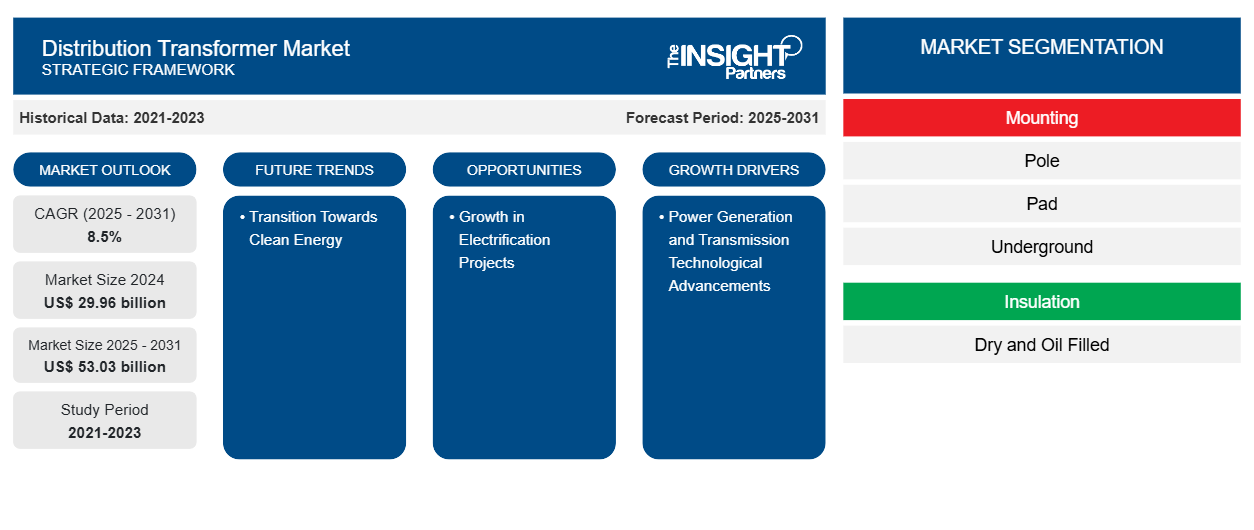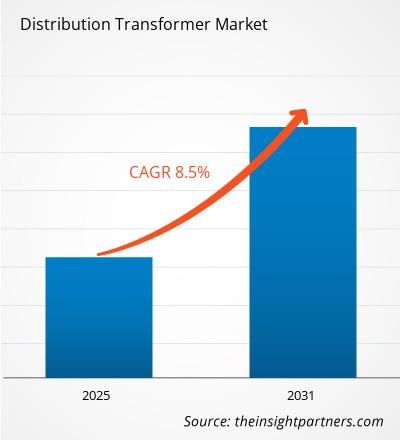The distribution transformer market size is projected to reach US$ 53.03 billion by 2031 from US$ 27.61 billion in 2023. The market is expected to register a CAGR of 8.5% in 2023–2031. The transition towards a clean energy future is likely to remain a key distribution transformer market trend.
Distribution Transformer Market Analysis
A service transformer provides the last voltage transformation in the electric power distribution system, scaling down the voltage utilized in the distribution lines to the level required by the consumer. Distribution transformers on the market often do not function at full load; instead, they are designed to provide optimal efficiency at lower loads. Voltage regulation in these transformers is maintained to a minimum to increase efficiency. As a result, these transformers are designed to have low leakage reactance.
Transformers with power ratings less than 500 kVA are commonly referred to as distribution transformers. Industries employ distribution transformers with voltage distribution of less than 33 KV, whereas households use 380V/220V distribution transformers. The number of consumers served by a single distribution transformer varies according to the number of customers in the area. In cities, many households can be served by a single transformer; in rural areas, one transformer per client may be required. A large commercial or industrial complex would necessitate numerous distribution transformers. Pad mount transformers are utilized in metropolitan regions and communities where principal distribution lines are underground.
Distribution Transformer Market Overview
The distribution transformer market includes both power and distribution transformers, which have grown significantly in recent years as energy demand has increased across various industries and geographies. Transformers are critical components in power generation, allowing for efficient transmission, distribution, and regulation of electrical energy. Their capacity to alter voltage levels guarantees that electricity is delivered reliably to end customers. Transformers play an important part in power generation because they enable the efficient transmission and distribution of electrical energy. These devices convert voltage levels, allowing power to be sent across vast distances with minimal loss. According to statistics from the Indian Electrical and Electronics Manufacturers Association, market output has increased by 7%, but power transformer production has increased by only 2%.
Customize This Report To Suit Your Requirement
You will get customization on any report - free of charge - including parts of this report, or country-level analysis, Excel Data pack, as well as avail great offers and discounts for start-ups & universities
Distribution Transformer Market: Strategic Insights

-
Get Top Key Market Trends of this report.This FREE sample will include data analysis, ranging from market trends to estimates and forecasts.
Distribution Transformer Market Drivers and Opportunities
Power Generation and Transmission Technological Advancements to Favor Market
The expansion of microgrids and energy utilities has raised acceptability and demand for more flexible electrical transformers, which is driving the growth of the distribution transformer market. Many electronics applications use step-down transformers with voltages of 5V, 6V, 9V, 12V, 24V, and 48V. Step-down transformers are widely utilized in the electrical industry. The use of microgrids and power systems in the electrical industry is increasing, as is the use of step-down transformers. This is because step-down transformers are utilized in electrical distribution systems for very high-voltage applications to provide a low-loss, cost-effective solution for long-distance power delivery.
Rapid Industrialization and Rising Domestic Power Need to Favor Market
The market for power transformers is growing due to fast industrialization and rising domestic power demand. Demand for power is constantly increasing, resulting in greater usage of energy resources. As a result, the world now boasts more power plants and extensive transmission networks. Electricity usage in the automotive industry is increasing as improved electric vehicles and incentives to use them become more prevalent. The bulk of power plants are located in remote areas, and the electricity generated is then transported to substations via HVDC power transmission lines before being delivered to end users via step-down.
Growth in Electrification Projects– An Opportunity in the Distribution Transformer Market
Countries in Southeast Asia, the Middle East, and Africa are likely to witness distribution transformer capacity additions to support their development objectives. Grid expansion and upgrades, growing demand for electricity, and increasing adoption of electrification projects are primary factors contributing to the market expansion.
Distribution Transformer Market Report Segmentation Analysis
Key segments that contributed to the derivation of the distribution transformer market analysis are mounting, insulation, phase, power, and application.
- Based on mounting, the market is divided into pole, pad, and underground. The pad segment held a larger market share in 2023.
- Based on insulation, the market is bifurcated into dry and oil-filled. The oil-filled segment held a larger market share in 2023.
- Based on phase, the market is bifurcated into single and three. The three-phase segment held a larger market share in 2023.
- In terms of power, the market is segmented into Lip to 0.5 MVA, 0.5 MVA-2.5 MVA, 2.5 MVA-IO MVA, and above 10 MVA. The 0.5 MVA-2.5 MVA segment dominated the market in 2023.
- Based on application, the market is bifurcated into residential, commercial, industrial, and utility. The commercial segment held a larger market share in 2023
Distribution Transformer Market Share Analysis by Geography
The geographic scope of the distribution transformer market report is mainly divided into five regions: North America, Asia Pacific, Europe, Middle East & Africa, and South America/South & Central America.
The distribution transformer market in Asia Pacific is significantly growing. The Distribution Transformer Market is currently in the growth phase and experiencing exponential growth. Increased manufacturing activity and electrification projects in Asian countries, such as India, Bangladesh, and Vietnam, are key market drivers. The rapid development in the number of manufacturing and industrial units has increased demand for these transformers. The expansion of railways, metros, IT hubs, commercial areas, bullet trains, and other infrastructure necessitates the usage of distribution transformers to ensure a stable and reliable energy supply.
Distribution Transformer Market Regional InsightsThe regional trends and factors influencing the Distribution Transformer Market throughout the forecast period have been thoroughly explained by the analysts at The Insight Partners. This section also discusses Distribution Transformer Market segments and geography across North America, Europe, Asia Pacific, Middle East and Africa, and South and Central America.
Distribution Transformer Market Report Scope
| Report Attribute | Details |
|---|---|
| Market size in 2024 | US$ 29.96 billion |
| Market Size by 2031 | US$ 53.03 billion |
| Global CAGR (2025 - 2031) | 8.5% |
| Historical Data | 2021-2023 |
| Forecast period | 2025-2031 |
| Segments Covered |
By Mounting
|
| Regions and Countries Covered |
North America
|
| Market leaders and key company profiles |
|
Distribution Transformer Market Players Density: Understanding Its Impact on Business Dynamics
The Distribution Transformer Market is growing rapidly, driven by increasing end-user demand due to factors such as evolving consumer preferences, technological advancements, and greater awareness of the product's benefits. As demand rises, businesses are expanding their offerings, innovating to meet consumer needs, and capitalizing on emerging trends, which further fuels market growth.

- Get the Distribution Transformer Market top key players overview
Distribution Transformer Market News and Recent Developments
The distribution transformer market is evaluated by gathering qualitative and quantitative data post primary and secondary research, which includes important corporate publications, association data, and databases. The following is a list of developments in the market for innovations, business expansion, and strategies:
- In February 2024, Siemens Energy addressed the national shortage of power transformers across the U.S. by investing US$ 150 million to expand operations in Charlotte, North Carolina, creating almost 600 local jobs. (Source: Siemens Energy, Press Release)
- In March 2022, The State Grid Corporation of China (SGCC), the country's main grid operator, ordered two 110-kilovolt, 63-megavolt, ampere EconiQTM power transformers from Hitachi Energy for an innovative substation project carried out in Jiangsu Province on China's east coast. This project aimed to advance the use of maintainable technology, which is consistent with the policies of SGCC and Hitachi Energy. (Source: State Grid Corporation of China (SGCC), Newsletter)
Distribution Transformer Market Report Coverage and Deliverables
The “Distribution Transformer Market Size and Forecast (2021–2031)” report provides a detailed analysis of the market covering the following areas:
- Distribution TransformerMarket size and forecast at global, regional, and country levels for all the key market segments covered under the scope
- Market dynamics such as drivers, restraints, and key opportunities
- Distribution Transformer Market trends
- Detailed PEST/Porter’s Five Forces and SWOT analysis
- Distribution Transformer market analysiscovering key market trends, Global and regional framework, major players, regulations, and recent market developments
- Distribution TransformerIndustry, landscape and competition analysis, covering market concentration, heat map analysis, prominent players, and recent developments
- Detailed company profiles
- Historical Analysis (2 Years), Base Year, Forecast (7 Years) with CAGR
- PEST and SWOT Analysis
- Market Size Value / Volume - Global, Regional, Country
- Industry and Competitive Landscape
- Excel Dataset
Recent Reports
Testimonials
Reason to Buy
- Informed Decision-Making
- Understanding Market Dynamics
- Competitive Analysis
- Identifying Emerging Markets
- Customer Insights
- Market Forecasts
- Risk Mitigation
- Boosting Operational Efficiency
- Strategic Planning
- Investment Justification
- Tracking Industry Innovations
- Aligning with Regulatory Trends





















 Get Free Sample For
Get Free Sample For